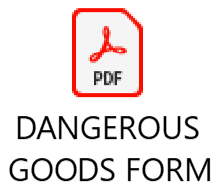DANGEROUS CARGO, IMO CODES AND SYMBOLS
GENERAL INFORMATION ABOUT THE MULTIMODAL DANGEROUS GOODS TRANSPORT FORM
Certain substances can endanger the safety of a vessel and the people on board, as well as the environment. These dangerous goods may be prohibited or restricted in maritime transportation.
You can find banned or restricted UN numbers from the attached list.
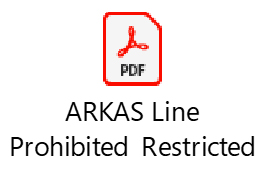
CLASSIFICATION OF DANGEROUS GOODS
The International Maritime Dangerous Goods (IMDG) Code was developed as a uniform international code for the transport of dangerous goods by sea covering such matters as packing, container traffic and stowage, with particular reference to the segregation of incompatible substances.
The Carriage of dangerous goods and marine pollutants in sea-going ships is respectively regulated in the International Convention for the Safety of the Life at Sea (SOLAS) and the International Convention for the Prevention of pollution from Ships (MARPOL).
Relevant parts of both SOLAS and MARPOL have been worked out in great detail and are included in the International Maritime Dangerous Goods (IMDG) Code, thus making this Code the legal instrument for maritime transport of dangerous goods and marine pollutants. As of 1st January 2004, the IMDG Code has become a mandatory requirement.
For all modes of transport (sea, air, rail, road and inland waterways) the classification (grouping) of dangerous goods, by type of risk involved, has been drawn up by the UNITED NATIONS Committee of Experts on the Transport of Dangerous Goods (UN).
Class 1:Explosives
Class 2 :Gases
Class 3:Flammable Liquids
Class 4:Flammable solids or substances
Class 5: Oxidizing substances and organic peroxides
Class 7:Radioactive material
Class 8:Corrosive substances
Class 9:Miscellaneous dangerous substances and articles and environmentally hazardous substances
Arkas Line provides services to its customers by offering them high performance and quality with its expertise and experience in dangerous goods. When it comes to the transportation of these goods, our company is highly aware of how important every single detail is. Therefore, all dangerous cargoes that have been declared are carefully examined and only suitable ones are accepted.
Arkas Line is an organization that puts people and life at the core of its existence. Our aim is to ensure that dangerous goods are carried as safely as possible by providing our customers with proper guidance. To achieve this, we apply all safety standards while fulfilling our commitments to the environment and human health.
Arkas Line pays great attention to safety and environmental protection during the transportation of dangerous goods. Our expert teams take the necessary precautions for proper packaging, marking and shipping of dangerous goods. We operate within the framework of international regulations, particularly IMDG and IMO, and local legal requirements.
As Arkas Line, we aim for excellence in the services we provide to our customers. Our dangerous goods department is committed to providing a reliable and effective service by constantly observing and improving quality standards. Customer satisfaction is our priority, and we provide uninterrupted support at every stage of the transport of dangerous goods.
At Arkas Line, a company specialized in the transportation of dangerous goods, we always prioritize the environment and human life. While providing our customers with safe, fast and sustainable solutions, we also strive to minimize environmental impacts and contribute to the welfare of society.
GENERAL INFORMATION ABOUT THE MULTIMODAL DANGEROUS GOODS TRANSPORT FORM
Dangerous Goods Classes
There are 9 classes of dangerous goods defining the risks of dangerous cargo. They are registered in the 'International Maritime Dangerous Goods Code (IMDG-CODE).
IMO- UN Number
The United Nations (UN) number, assigned by IMO (International Maritime Organization) to a dangerous substance, is registered.
Packing group
This marks the packing group of your shipment. While Packing Group I indicates the most dangerous substances in the dangerous goods class, Packing Group II presents substances with medium danger, and Packing Group III defines substances presenting the least danger.
Flash Point
Flashpoint means the lowest temperature of a liquid at which its vapor forms an ignitable mixture with air. This information is available on the MSDS.
Marine Pollutant
Indicates whether the material will pollute seawater.
Limited Quantity
This field specifies whether your dangerous goods can be shipped as 'Limited Quantity' according to IMDG-Code section 3.4.
Segregation
Segregation is the process of separating two or more substances or objects considered mutually incompatible, since dangerous goods packed or stacked together may cause greater hazards in the event of leakage, spillage, or other accidents. Please refer to IMDG code section 7.2.
Emergency contact person and phone number
Information for authorized contacts should be included in case of danger.
There are 9 classes of dangerous goods defining the risks of dangerous cargo. They are registered in the 'International Maritime Dangerous Goods Code (IMDG-CODE).
IMO- UN Number
The United Nations (UN) number, assigned by IMO (International Maritime Organization) to a dangerous substance, is registered.
Packing group
This marks the packing group of your shipment. While Packing Group I indicates the most dangerous substances in the dangerous goods class, Packing Group II presents substances with medium danger, and Packing Group III defines substances presenting the least danger.
Flash Point
Flashpoint means the lowest temperature of a liquid at which its vapor forms an ignitable mixture with air. This information is available on the MSDS.
Marine Pollutant
Indicates whether the material will pollute seawater.
Limited Quantity
This field specifies whether your dangerous goods can be shipped as 'Limited Quantity' according to IMDG-Code section 3.4.
Segregation
Segregation is the process of separating two or more substances or objects considered mutually incompatible, since dangerous goods packed or stacked together may cause greater hazards in the event of leakage, spillage, or other accidents. Please refer to IMDG code section 7.2.
Emergency contact person and phone number
Information for authorized contacts should be included in case of danger.
You can find banned or restricted UN numbers from the attached list.

CLASSIFICATION OF DANGEROUS GOODS
The International Maritime Dangerous Goods (IMDG) Code was developed as a uniform international code for the transport of dangerous goods by sea covering such matters as packing, container traffic and stowage, with particular reference to the segregation of incompatible substances.
The Carriage of dangerous goods and marine pollutants in sea-going ships is respectively regulated in the International Convention for the Safety of the Life at Sea (SOLAS) and the International Convention for the Prevention of pollution from Ships (MARPOL).
Relevant parts of both SOLAS and MARPOL have been worked out in great detail and are included in the International Maritime Dangerous Goods (IMDG) Code, thus making this Code the legal instrument for maritime transport of dangerous goods and marine pollutants. As of 1st January 2004, the IMDG Code has become a mandatory requirement.
For all modes of transport (sea, air, rail, road and inland waterways) the classification (grouping) of dangerous goods, by type of risk involved, has been drawn up by the UNITED NATIONS Committee of Experts on the Transport of Dangerous Goods (UN).
Class 1:Explosives
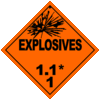 |
Subclass 1.1: Explosives with a mass explosion hazard Consists of explosives that have a mass explosion hazard. A mass explosion is one which affects almost the entire load instantaneously. |
|
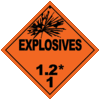 |
Subclass 1.2: Explosives with a severe projection hazard Consists of explosives that have a projection hazard but not a mass explosion hazard. |
|
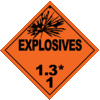 |
Subclass 1.3: Explosives with a fire Consists of explosives that have a fire hazard and either a minor blast hazard or a minor projection hazard or both but not a mass explosion hazard. |
|
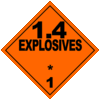 |
Subclass 1.4: Minor fire or projection hazard Consists of explosives that present a minor explosion hazard. The explosive effects are largely confined to the package and no projection of fragments of appreciable size or range is to be expected. An external fire must not cause virtually instantaneous explosion of almost the entire contents of the package. |
|
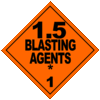 |
Subclass 1.5: An insensitive substance with a mass explosion hazard Consists of very insensitive explosives with a mass explosion hazard (explosion similar to 1.1). This division is comprised of substances which have a mass explosion hazard but are so insensitive that there is very little probability of initiation or of transition from burning to detonation under normal conditions of transport. |
|
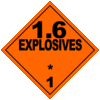 |
Subclass 1.6: Extremely insensitive articles Consists of extremely insensitive articles which do not have a mass explosive hazard. This division is comprised of articles which contain only extremely insensitive detonating substances and which demonstrate a negligible probability of accidental initiation or propagation. |
|
Class 2 :Gases
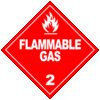 |
Subclass 2.1: Flammable Gas Gases which ignite on contact with an ignition source, such as acetylene and hydrogen. Flammable gas means any material which is ignitable at 101.3 kPa (14.7 psi) when in a mixture of 13 percent or less by volume with air, or has a flammable range at 101.3 kPa (14.7 psi) with air of at least 12 percent regardless of the lower limit. |
|
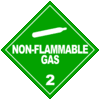 |
Subclass 2.2: Non-Flammable Gases Gases which are neither flammable nor poisonous. Includes the cryogenic gases/liquids (temperatures of below -100°C) used for cryopreservation and rocket fuels. This division includes compressed gas, liquefied gas, pressurized cryogenic gas, compressed gas in solution, asphyxiant gas and oxidizing gas. A non-flammable, nonpoisonous compressed gas means any material which exerts in the packaging an absolute pressure of 280 kPa (40.6 psia) or greater at 20°C (68°F), and does not meet the definition of Division 2.1 or 2.3. |
|
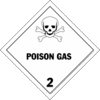 |
Subclass 2.3: Poisonous Gases Gases liable to cause death or serious injury to human health if inhaled. Gas poisonous by inhalation means a material which is a gas at 20°C or less and a pressure of 101.3 kPa (a material which has a boiling point of 20°C or less at 101.3kPa (14.7 psi)) which is known to be so toxic to humans as to pose a hazard to health during transportation, or in the absence of adequate data on human toxicity, is presumed to be toxic to humans because when tested on laboratory animals it has an LC50 value of not more than 5000 ml/m3. |
|
Class 3:Flammable Liquids
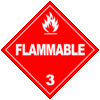 |
A flammable liquid means a liquid which may catch fire easily or any mixture having one or more components whith any flash point. As example: acetone, diesel, gasoline, kerosene, oil etc. Transportation is strongly recommended at or above its flash point in a bulk packaging. There are three main groups of flammable liquid.
|
Class 4:Flammable solids or substances
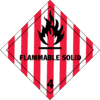 |
Subclass 4.1: Flammable solids For the purpose of this Code, flammable solids means readily combustible solids and solids which may causefire through friction. |
|
 |
Subclass 4.1: Self-reactive substances Self-reactive substances are thermally unstable substances liable to undergo a strongly exothermic decomposition even without participation of oxygen (air). |
|
 |
Subclass 4.1: Solid desensitized explosives Solid desensitized explosives are explosive substances which are wetted with water or alcohols or are diluted with other substances to form a homogeneous solid mixture to suppress their explosive properties. |
|
 |
Subclass 4.1: Polymerizing substances and mixtures (stabilized) Polymerizing substances are substances which, without stabilization, are liable to undergo a strongly exothermic reaction resulting in the formation of larger molecules or resulting in the formation of polymers under conditions normally encountered in transport. Explosives included under class 1 however deactivated or substances specially included under this class by the producer. |
|
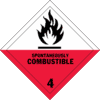 |
Subclass 4.2: Substances liable to spontaneous combustion |
|
 |
Subclass 4.2: Comprises 1 Pyrophoric substances, which are substances, including mixtures and solutions (liquid or solid), which, even in small quantities, ignite within 5 minutes of coming into contact with air. These substances are the most liable to spontaneous combustion; and 2 Self-heating substances, which are substances, other than pyrophoric substances, which, in contact with air without energy supply, are liable to self-heating. These substances will ignite only when in large amounts (kilograms) and after long periods of time (hours or days). |
|
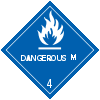 |
Subclass 4.3: Substances which, in contact with water, emit flammable gases For the purpose of this Code, the substances in this class are either liquids or solids which, by interaction with water, are liable to become spontaneously flammable or to give off flammable gases in dangerous quantities. |
|
Class 5: Oxidizing substances and organic peroxides
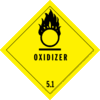 |
Subclass 5.1: Oxidizing substances Substances which, while in themselves not necessarily combustible, may, generally by yielding oxygen,cause, or contribute to, the combustion of other material. Such substances may be contained in an article. |
|
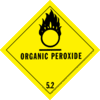 |
Subclass 5.2: Organic peroxides Organic substances which contain the bivalent –O–O– structure and may be considered derivatives of hydrogen peroxide, where one or both of the hydrogen atoms have been replaced by organic radicals. Organic peroxides are thermally unstable substances which may undergo exothermic self-accelerating decomposition. |
|
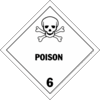 |
Subclass 6.1: Toxic substances Toxic substances which are able to cause death or serious hazard to humans health during transportation. |
|
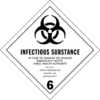 |
Subclass 6.2: Infectious substances These are substances known or reasonably expected to contain pathogens. Pathogens are defined as microorganisms (including bacteria, viruses, rickettsiae, parasites, fungi) and other agents such as prions, which can cause disease in humans or animals. |
|
Class 7:Radioactive material
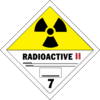 |
Radioactive material means any material containing radionuclides where both the activity concentration and the total activity in the consignment exceed the values specified in 2.7.2.2.1 to 2.7.2.2.6. |
Class 8:Corrosive substances
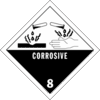 |
Class 8 substances (corrosive substances) means substances which, by chemical action, will cause severe damage when in contact with living tissue or, in the case of leakage, will materially damage, or even destroy, other goods or the means of transport. |
Class 9:Miscellaneous dangerous substances and articles and environmentally hazardous substances
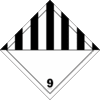 |
substances and articles (miscellaneous dangerous substances and articles) are substances and articles which, during transport, present a danger not covered by other classes.
|



